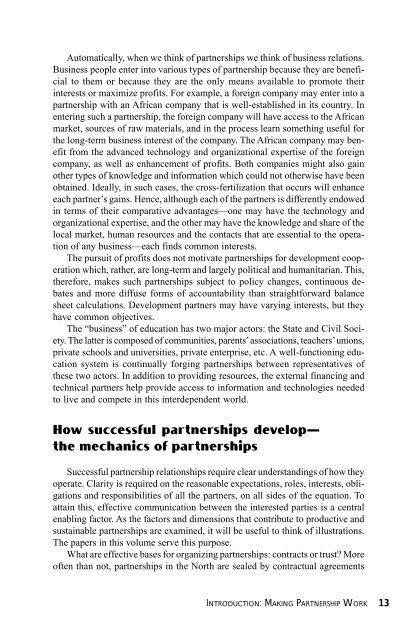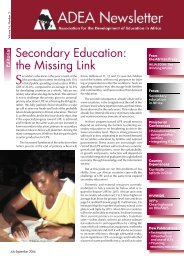Partnerships for Capacity Building and Quality ... - ADEA
Partnerships for Capacity Building and Quality ... - ADEA
Partnerships for Capacity Building and Quality ... - ADEA
Create successful ePaper yourself
Turn your PDF publications into a flip-book with our unique Google optimized e-Paper software.
Automatically, when we think of partnerships we think of business relations.Business people enter into various types of partnership because they are beneficialto them or because they are the only means available to promote theirinterests or maximize profits. For example, a <strong>for</strong>eign company may enter into apartnership with an African company that is well-established in its country. Inentering such a partnership, the <strong>for</strong>eign company will have access to the Africanmarket, sources of raw materials, <strong>and</strong> in the process learn something useful <strong>for</strong>the long-term business interest of the company. The African company may benefitfrom the advanced technology <strong>and</strong> organizational expertise of the <strong>for</strong>eigncompany, as well as enhancement of profits. Both companies might also gainother types of knowledge <strong>and</strong> in<strong>for</strong>mation which could not otherwise have beenobtained. Ideally, in such cases, the cross-fertilization that occurs will enhanceeach partner’s gains. Hence, although each of the partners is differently endowedin terms of their comparative advantages—one may have the technology <strong>and</strong>organizational expertise, <strong>and</strong> the other may have the knowledge <strong>and</strong> share of thelocal market, human resources <strong>and</strong> the contacts that are essential to the operationof any business—each finds common interests.The pursuit of profits does not motivate partnerships <strong>for</strong> development cooperationwhich, rather, are long-term <strong>and</strong> largely political <strong>and</strong> humanitarian. This,there<strong>for</strong>e, makes such partnerships subject to policy changes, continuous debates<strong>and</strong> more diffuse <strong>for</strong>ms of accountability than straight<strong>for</strong>ward balancesheet calculations. Development partners may have varying interests, but theyhave common objectives.The “business” of education has two major actors: the State <strong>and</strong> Civil Society.The latter is composed of communities, parents’ associations, teachers’ unions,private schools <strong>and</strong> universities, private enterprise, etc. A well-functioning educationsystem is continually <strong>for</strong>ging partnerships between representatives ofthese two actors. In addition to providing resources, the external financing <strong>and</strong>technical partners help provide access to in<strong>for</strong>mation <strong>and</strong> technologies neededto live <strong>and</strong> compete in this interdependent world.How successful partnerships develop—the mechanics of partnershipsSuccessful partnership relationships require clear underst<strong>and</strong>ings of how theyoperate. Clarity is required on the reasonable expectations, roles, interests, obligations<strong>and</strong> responsibilities of all the partners, on all sides of the equation. Toattain this, effective communication between the interested parties is a centralenabling factor. As the factors <strong>and</strong> dimensions that contribute to productive <strong>and</strong>sustainable partnerships are examined, it will be useful to think of illustrations.The papers in this volume serve this purpose.What are effective bases <strong>for</strong> organizing partnerships: contracts or trust? Moreoften than not, partnerships in the North are sealed by contractual agreementsINTRODUCTION: MAKING PARTNERSHIP WORK 13

















